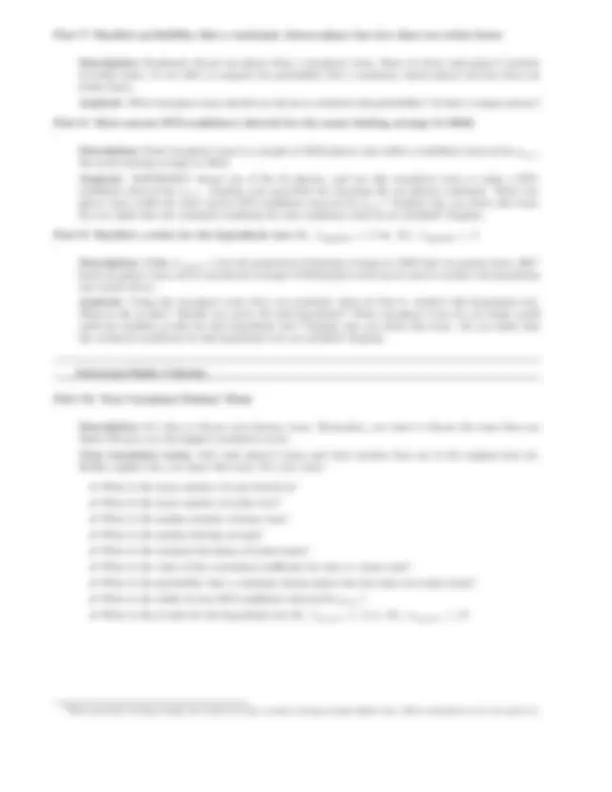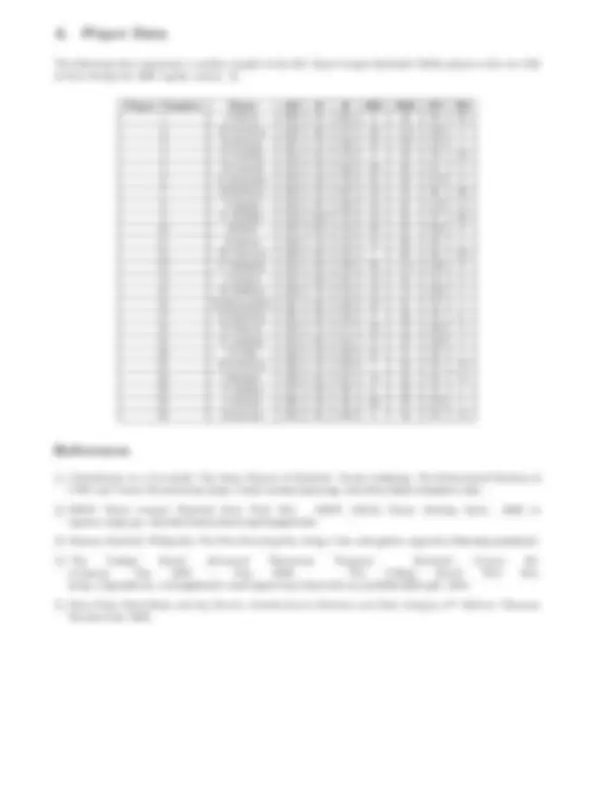




Study with the several resources on Docsity

Earn points by helping other students or get them with a premium plan


Prepare for your exams
Study with the several resources on Docsity

Earn points to download
Earn points by helping other students or get them with a premium plan
Community
Ask the community for help and clear up your study doubts
Discover the best universities in your country according to Docsity users
Free resources
Download our free guides on studying techniques, anxiety management strategies, and thesis advice from Docsity tutors
Material Type: Project; Professor: Best; Class: Applied Statistics; Subject: Mathematics; University: Western Carolina University; Term: Fall 2006;
Typology: Study Guides, Projects, Research
1 / 4

This page cannot be seen from the preview
Don't miss anything!



MATH 170 - Applied Statistics The Fantasy Baseball Project DUE by Friday, December 8th, 2006
Project Description: From a pool of 25 Major League Baseball (MLB) players, you will choose a ten-player team. Your choice of team will be based on the statistical analysis of several categories. You can find the pool of 25 players in Appendix A. These 25 players are a simple random sample of all players in MLB with at least 350 at-bats during the 2006 season.
This project consists of ten different parts with two different frames of mind.
Suppose there are n different values in the class for a given “best team characteristic”. If your fantasy team is the best for this characteristic, you will get n points; if your team is second best, you will get n − 1 points; if your team is the worst, you will get 1 point. This will be done for each of the nine best team characteristics. You win if you have the highest cumulative number of points in the class.
Single Minded Criteria:
Part 1: Most Runs Batted In Per Player
Description: A player’s number of runs batted in appears in the column labeled RBI. Two common interpretations of the word “most” are: the highest mean of your ten values and the highest median of your ten values. For this part we will use the highest mean interpretation. Analysis: Make a graphical display of the RBI data (all 25 points). You can choose from: histogram (with equal or unequal class-interval lengths), stem-and-leaf plot, boxplot, and dotplot. If you choose to make a histogram, include a frequency table. What ten-man team should you choose if “most” means “highest mean?” Is there a single answer to this question? Explain.
Part 2: Fewest strike outs per player
Description: The number of times a player struck out is in the column labeled SO. Two common inter- pretations of the word “fewest” are: the smallest mean of your ten values and the smallest median of your ten values. For this part we will use the smallest mean interpretation. Analysis: Make a graphical display of the SO data (all 25 points). Your choice here must be different than your choice in Part 1. What ten-man team should you choose if “fewest” means “smallest mean?”
Part 3: Most home runs per player
Description: A player’s number of home runs is in the column labeled HR. For this part we will use the “highest median” interpretation of the word “most.” Analysis: Make a graphical display of the HR data (all 25 points). Your choice here must be different than your choices in Parts 1 and 2. What ten-man team should you choose if “highest” means “highest median?” Is there a single answer to this question? Explain.
Part 4: Highest batting average per player
Description: A player’s batting average is computed by dividing his number of hits by his number of at-bats (H/AB). For this part we will use the “highest median” interpretation of the word “highest.” Analysis: This data does not appear in the data set directly, so insert an “AVG” column. Make a graphical display of the batting average data (all 25 points). Your choice here must be different than your choices in Parts 1, 2, and 3. What ten-man team should you choose if “highest” means “highest median?”
Part 5: Least variation in stolen bases per player
Description: The number of bases that a player stole is in the column labeled SB. Three common statistical interpretations of the word “variation” are: the range, the interquartile range, and the standard deviation of your ten values. Analysis: Make a dotplot of the SB data (all 25 points). What ten-man team should you choose if “variation” means “range?” What if “variation” means “interquartile range?” What if “variation” means “standard deviation?” Use your dotplot to help explain why you chose each team.
Part 6: Strongest linear relationship between number of runs and number of home runs
Description: You want a team for which the number of runs (R) and the number of home runs (HR) have the strongest linear relationship. Analysis: Make a scatterplot of R vs. HR. (Place R on the horizontal axis.) What ten-player team appears to have a very strong linear relationship between these variables? Identify your team on the scatterplot. For this team, what is the correlation coefficient?
The following data represents a random sample of the 221 Major League Baseball (MLB) players with over 350 at-bats during the 2006 regular season. [2]
Player Number Name AB R H HR RBI SO SB 1 J Pierre 699 87 204 3 40 38 58 2 M Teixeira 628 99 177 33 110 128 2 3 R Sexson 591 75 156 34 107 154 1 4 L Castillo 584 84 173 3 49 58 25 5 M Lowell 573 79 163 20 80 61 2 6 A Gonzalez 570 83 173 24 82 113 0 7 B Roberts 563 85 161 10 55 66 36 8 T Iguchi 555 97 156 18 67 110 11 9 C Guillen 543 100 174 19 85 87 20 10 B Hall 537 101 145 35 85 162 8 11 S Green 530 73 147 15 66 82 4 12 W Taveras 529 83 147 1 30 88 33 13 C Delgado 524 89 139 38 114 120 0 14 J Mauer 521 86 181 13 84 54 8 15 M DeRosa 520 78 154 13 74 102 4 16 R Hernandez 501 66 138 23 91 79 1 17 D DeJesus 491 83 145 8 56 70 6 18 E Chavez 485 74 117 22 72 100 3 19 G Jenkins 484 62 131 17 70 129 4 20 J Uribe 463 53 109 21 71 82 1 21 M Cabrera 460 75 129 7 50 59 12 22 I Kinsler 423 65 121 14 55 64 11 23 Y Molina 417 29 90 6 49 41 1 24 J Gomes 385 53 83 20 59 116 1 25 M Izturis 352 64 103 5 44 35 14
[1] Calculations on a Curveball: The Many Figures of Baseball. Turner Le@rning: The Educational Division of CNN and Turner Broadcasting http://www.turnerlearning.com/efts/bball/numbers.htm.
[2] ESPN Major League Baseball Data Web Site. ESPN (MLB) Player Batting Stats: 2006 at sports.espn.go.com/mlb/stats/batting?league=mlb.
[3] Fantasy Baseball. Wikipedia, The Free Encyclopedia: http://en.wikipedia.org/wiki/Fantasy baseball.
[4] The College Board Advanced Placement Program: Statistics Course De- scription, May 2005 - May 2006. The College Board Web Site, http://apcentral.collegeboard.com/repository/statistics cd 0506 4328.pdf, 2004.
[5] Roxy Peck, Chris Olsen, and Jay Devore. Introduction to Statistics and Data Analysis, 2 nd^ Edition. Thomson Brooks/Cole, 2005.